Impactos de la desaparición del ferrocarril en dos municipios del noroeste de México
Impacts of the disappearance of the railroad in two municipalities of the northwest of Mexico
Abstract
Objective: Analyze the main impacts caused by the disappearance of railway activity in the dawn of 2000, in two municipalities of Mexico: Empalme and Nuevo Casas Grandes. These municipalities were founded, precisely, thanks to the start of this activity. Methodology: Is the Human Poverty Index (UN) that allows obtaining a multidimensional measurement, in four aspects: income, education, housing and health. Additionally, we generated geostatistical maps for both municipalities, and the train route. Results: Point to an index of 24.06 % of human poverty for Nuevo Casas Grandes and 23.21 % for Empalme. To complement the work, the planning of local governments was incorporated, during the period of analysis (2003-2016), interested in detecting, what diagnoses, actions or proposals were carried out in relation to poverty. Limitations: The main limitation of the study is that the HPI does not cover all the qualitative elements that may influence in estimating or measuring a context of poverty, such as social programs and social cohesion, however, it takes up three commonly recurrent approaches to measure poverty and the Human Development Index (HDI). Conclusions: Allow us to affirm that the disappearance of the railway, without a doubt, affected the economic trajectory of the municipalities and reconfigured the productive activities towards other vocations, such as the maquiladoras and agriculture. Meanwhile, local governments have shown little interest in proposing actions to combat poverty.Keywords:
egional development, human poverty, railway, development plan, municipalities, Basic Geostatistics Area.Abstract
Objective: Analyze the main impacts caused by the disappearance of railway activity in the dawn of 2000, in two municipalities of Mexico: Empalme and Nuevo Casas Grandes. These municipalities were founded, precisely, thanks to the start of this activity. Methodology: Is the Human Poverty Index (UN) that allows obtaining a multidimensional measurement, in four aspects: income, education, housing and health. Additionally, we generated geostatistical maps for both municipalities, and the train route. Results: Point to an index of 24.06 % of human poverty for Nuevo Casas Grandes and 23.21 % for Empalme. To complement the work, the planning of local governments was incorporated, during the period of analysis (2003-2016), interested in detecting, what diagnoses, actions or proposals were carried out in relation to poverty. Limitations: The main limitation of the study is that the HPI does not cover all the qualitative elements that may influence in estimating or measuring a context of poverty, such as social programs and social cohesion, however, it takes up three commonly recurrent approaches to measure poverty and the Human Development Index (HDI). Conclusions: Allow us to affirm that the disappearance of the railway, without a doubt, affected the economic trajectory of the municipalities and reconfigured the productive activities towards other vocations, such as the maquiladoras and agriculture. Meanwhile, local governments have shown little interest in proposing actions to combat poverty.Keywords:
egional development, human poverty, railway, development plan, municipalities, Basic Geostatistics Area.Downloads
References
Collado, M. D. (2016). Thomas Braniff y la construcción del ferrocarril. Mirada Ferroviaria, 26(5).
González, J. D. (2018). El transporte ferroviario. H. Camara de Diputados, LVIII Legislatura. México: CESOP.
Grunstein, A. (2008). A un siglo de la consolidación: nueva evidencia documental sobre el nacimiento de los ferrocarriles nacionales de México. C. N. Ferrocarrilero, Ed. México: Mirada Ferroviaria (06).
INEGI (2010). Censo General de Población y Vivienda. Recuperado de: https://www.inegi.org.mx/programas/ccpv/2010/
Juárez, P. (2014). Los ferrocarriles y el maderismo 1910-1913. Mirada Ferroviaria. Recuperado de: http://www.chihuahuamexico.com/index.php?option=com_content& task=view&id=6139&Itemid=30
López, H (2006). "Ferrocarriles Mexicanos: del monopolio de estado al oligopolio privado y extranjero". Agenda para la reforma del Estado. Recuperado de: https://archivos.juridicas.unam.mx/www/bjv/libros/6/2519/28.pdf
Mireles, A. L. (2005). Desarrollo regional y cultural del estado de Chihuahua. Archivo de la biblioteca municipal, Nuevo Casas Grandes.
Plan de Desarrollo Municipal, Empalme (2003-2006). Presidente. Juan Manuel Sauceda Morales.
Plan de Desarrollo Municipal, Empalme (2006-2009). Presidente. Samuel Rodríguez Sánchez.
Plan de Desarrollo Municipal, Empalme (2009-2012). Presidente Javier Caraveo Rincón.
Plan de Desarrollo Municipal, Empalme (2012-2015). Presidente Héctor Moisés Laguna Torres
Plan de Desarrollo Municipal, Nuevo Casas Grandes (2004-2007). Presidente Orlando Polanco Rascón.
Plan de Desarrollo Municipal, Nuevo Casas Grandes (2007-2010). Presidente Jesús Manuel Pendones.
Plan de Desarrollo Municipal, Nuevo Casas Grandes (2010-2013). Presidente Luis F. Coboss
Plan de Desarrollo Municipal, Nuevo Casas Grandes (2013-2016). Presidente Rodolfo Soltero Aguirre.
Programme, U. N. Human Development Report (1997). Estados Unidos: Oxford University Press.
Salazar, R. L. y Valdéz, H. D. (2016). Un índice de pobreza para Nuevo Casas Grandes. Chihuahua Hoy, 14, 18-26.
Sen, A. (1983). Poor, relatively speaking. Estados Unidos: Oxford Economic Papers, 35(2), 69-153.
Zamorano, E. (1984). Historia del Ferrocarril Chihuahua-Pacífico. Memoria del VIII Simposio de Historia y Antropología, pp. 301 - 317,1984. Universidad de Sonora, Departamento de Historia y Antropología
Published
How to Cite
Issue
Section
Para que sean publicados artículos, ensayos y reseñas críticas en Estudios Sociales, la revista debe contar con la aceptación de parte de los autores/autoras de las condiciones siguientes:
1. Los autores conservan los derechos de autor y ceden a la revista el derecho de la primera publicación del trabajo registrado bajo la licencia de Creative Commons Reconocimiento-NoComercial (CC-By-NC) que permite a terceros utilizar lo publicado, siempre y cuando mencionen la autoría del trabajo y a la primera publicación en esta revista.
2. Los autores pueden realizar otros acuerdos contractuales independientes y adicionales para la distribución no exclusiva de la versión del artículo publicado en esta revista (por ejemplo: incluirlo en un repositorio institucional o publicarlo en un libro) siempre y cuando indiquen, claramente, que el trabajo se publicó por primera vez en esta revista.




















